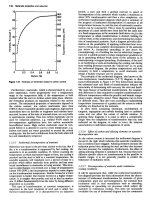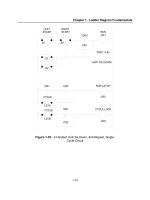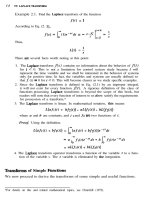Tài liệu Asea Brown Boveri Pocket Book P2 pptx
Bạn đang xem bản rút gọn của tài liệu. Xem và tải ngay bản đầy đủ của tài liệu tại đây (118.53 KB, 10 trang )
23
1
If two metals included in this table come into contact, the metal mentioned first will
corrode.
The less noble metal becomes the anode and the more noble acts as the cathode. As
a result, the less noble metal corrodes and the more noble metal is protected.
Metallic oxides are always less strongly electronegative, i. e. nobler in the electrolytic
sense, than the pure metals. Electrolytic potential differences can therefore also occur
between metal surfaces which to the engineer appear very little different. Even though
the potential differences for cast iron and steel, for example, with clean and rusty surfaces
are small, as shown in Table 1-9, under suitable circumstances these small differences
can nevertheless give rise to significant direct currents, and hence corrosive attack.
Table 1-9
Standard potentials of different types of iron against hydrogen, in volts
SM steel, clean surface approx. – 0.40 cast iron, rusty approx. – 0.30
cast iron, clean surface approx. – 0.38 SM steel, rusty approx. – 0.25
1.2.2 Faraday’s law
1. The amount m (mass) of the substances deposited or converted at an electrode is
proportional to the quantity of electricity Q = l · t.
m ~ l · t
1.2 Physical, chemical and technical values
1.2.1 Electrochemical series
If different metals are joined together in a manner permitting conduction, and both are
wetted by a liquid such as water, acids, etc., an electrolytic cell is formed which gives
rise to corrosion. The amount of corrosion increases with the differences in potential. If
such conducting joints cannot be avoided, the two metals must be insulated from each
other by protective coatings or by constructional means. In outdoor installations,
therefore, aluminium/copper connectors or washers of copper-plated aluminium sheet
are used to join aluminium and copper, while in dry indoor installations aluminium and
copper may be joined without the need for special protective measures.
Table 1-8
Electrochemical series, normal potentials against hydrogen, in volts.
1. Lithium approx. – 3.02 10. Zinc approx. – 0.77 19. Hydrogen approx. 0.0
2. Potassium approx. – 2.95 11. Chromium approx. – 0.56 20. Antimony approx. + 0.2
3. Barium approx. – 2.8 12. Iron approx. – 0.43 21. Bismuth approx. + 0.2
4. Sodium approx. – 2.72 13. Cadmium approx. – 0.42 22. Arsenic approx. + 0.3
5. Strontium approx. – 2.7 14. Thallium approx. – 0.34 23. Copper approx. + 0.35
6. Calcium approx. – 2.5 15. Cobalt approx. – 0.26 24. Silver approx. + 0.80
7. Magnesium approx. – 1.8 16. Nickel approx. – 0.20 25. Mercury approx. + 0.86
8. Aluminium approx. – 1.45 17. Tin approx. – 0.146 26. Platinum approx. + 0.87
9. Manganese approx. – 1.1 18. Lead approx. – 0.132 27. Gold approx. + 1.5
24
2. The amounts m (masses) of the substances converted from different electrolytes by
equal quantities of electricity Q = l · t behave as their electrochemical equivalent
masses M*. The equivalent mass M* is the molar mass M divided by the
electrochemical valency n (a number). The quantities M and M* can be stated in
g/mol.
M*
m = —
l
· t
F
If during electroysis the current
I
is not constant, the product
l
· t must be represented by the integral
͐
l
dt.
The quantity of electricity per mole necessary to deposit or convert the equivalent mass
of 1 g/mol of a substance (both by oxidation at the anode and by reduction at the
cathode) is equal in magnitude to Faraday's constant (F = 96480 As/mol).
Table 1-10
Electrochemical equivalents
1)
Valency Equivalent Quantity Approximate
n mass
2)
precipitated, optimum current
g/mol theoretical efficiency
g/Ah %
Aluminium 3 8.9935 0.33558 85 … 98
Cadmium 2 56.20 2.0970 95 … 95
Caustic potash 1 56.10937 2.0036 95
Caustic soda 1 30.09717 1.49243 95
Chlorine 1 35.453 1.32287 95
Chromium 3 17.332 0.64672 —
Chromium 6 8.666 0.32336 10 … 18
Copper 1 63.54 2.37090 65 … 98
Copper 2 31.77 1.18545 97 … 100
Gold 3 65.6376 2.44884 —
Hydrogen 1 1.00797 0.037610 100
Iron 2 27.9235 1.04190 95 … 100
Iron 3 18.6156 0.69461 —
Lead 2 103.595 3.80543 95 … 100
Magnesium 2 12.156 0.45358 —
Nickel 2 29.355 1.09534 95 … 98
Nickel 3 19.57 0.73022 —
Oxygen 2 7.9997 0.29850 100
Silver 1 107.870 4.02500 98 … 100
Tin 2 59.345 2.21437 70 … 95
Tin 4 29.6725 1.10718 70 … 95
Zinc 2 32.685 1.21959 85 … 93
1)
Relative to the carbon-12 isotope = 12.000.
2)
Chemical equivalent mass is molar mass/valency in g/mol.
Example:
Copper and iron earthing electrodes connected to each other by way of the neutral
conductor form a galvanic cell with a potential difference of about 0.7 V (see Table 1-8).
These cells are short-circuited via the neutral conductor. Their internal resistance is de-
t
2
t
1
25
1
termined by the earth resistance of the two earth electrodes. Let us say the sum of all
these resistances is 10 Ω. Thus, if the drop in “short-circuit emf” relative to the “open-
circuit emf” is estimated to be 50 % approximately, a continuous corrosion current of
35 mA will flow, causing the iron electrode to decompose. In a year this will give an
electrolytically active quantity of electricity of
hAh
35 mA · 8760 — = 306 —– .
aa
Since the equivalent mass of bivalent iron is 27.93 g/mol, the annual loss of weight from
the iron electrode will be
27.93 g/mol 3600 s
m = ————————— · 306 Ah/a · ————— = 320 g/a.
96480 As/mol h
1.2.3 Thermoelectric series
If two wires of two different metals or semiconductors are joined together at their ends
and the two junctions are exposed to different temperatures, a thermoelectric current
flows in the wire loop (Seebeck effect, thermocouple). Conversely, a temperature
difference between the two junctions occurs if an electric current is passed through the
wire loop (Peltier effect).
The thermoelectric voltage is the difference between the values, in millivolts, stated in
Table 1-11. These relate to a reference wire of platinum and a temperature difference of
100 K.
Table 1-11
Thermoelectric series, values in mV, for platinum as reference and temperature
difference of 100 K
Bismut ll axis –7.7 Rhodium 0.65
Bismut ⊥ axis –5.2 Silver 0.67 … 0.79
Constantan –3.37 … –3.4 Copper 0.72 … 0.77
Cobalt –1.99 … –1.52 Steel (V2A) 0.77
Nickel –1.94 … –1.2 Zinc 0.6 … 0.79
Mercury –0.07 … + 0.04 Manganin 0.57 … 0.82
Platinum ± 0 Irdium 0.65 … 0.68
Graphite 0.22 Gold 0.56 … 0.8
Carbon 0.25 … 0.30 Cadmium 0.85 … 0.92
Tantalum 0.34 … 0.51 Molybdenum 1.16 … 1.31
Tin 0.4 … 0.44 Iron 1.87 … 1.89
Lead 0.41 … 0.46 Chrome nickel 2.2
Magnesium 0.4 … 0.43 Antimony 4.7 … 4.86
Aluminium 0.37 … 0.41 Silicon 44.8
Tungsten 0.65 … 0.9 Tellurium 50
Common thermocouples
Copper/constantan Nickel chromium/nickel
(Cu/const) up to 500 °C (NiCr/Ni) up to 1 000 °C
Iron/constantan Platinum rhodium/
(Fe/const) up to 700 °C platinum up to 1 600 °C
Nickel chromium/ Platinum rhodium/
constantan up to 800 °C platinum rhodium up to 1 800 °C
26
1.2.4 pH value
The pH value is a measure of the “acidity” of aqueous solutions. It is defined as the
logarithm to base 10 of the reciprocal of the hydrogen ion concentration CH
3
O
1)
.
pH
≡
–log CH
3
O.
pH scale
1 m = 1 mol/l hydrochloric acid (3.6 % HCl —–0
0.1 m hydrochloric acid (0.36 % HCl)—–—–—–—–—–—–—–
gastric acid—–—–—–—–—–—–—–
—–1
—–2
vinegar ( ≈ 5 % CH
3
COOH)—–—–—–—–—–—–—–
—–3
acid
marsh water—–—–—–—–—–—–—–
—–4
—–5
—–6
river water—–—–—–—–—–—–—–—–7
tap water 20
Ω
m—–—–—–—–—–—–—– neutral
—–8
see water 0.15
Ω
m (4 % NaCl)—–—–—–—–—–—–—–
—–9
—–10
0.1 m ammonia water (0.17 % NH
3
)—–—–—–—–—–—–—–—–11
alkaline
saturated lime-water (0.17 % CaOH
2
)—–—–—–—–—–—–—–
—–12
0.1 m caustic soda solution (0.4 % NaOH)—–—–—–—–—–—–—–—–13
Fig. 1-1
pH value of some solutions
1)
CH
3
O = Hydrogen ion concentration in mol/l.
1.2.5 Heat transfer
Heat content (enthalpy) of a body: Q = V · ρ · c · ∆ϑ
V volume, ρ density, c specific heat, ∆ϑ temperature difference
Heat flow is equal to enthalpy per unit time:
Φ = Q/t
Heat flow is therefore measured in watts (1 W = 1 J/s).
27
1
Specific heat (specific thermal capacity) of a substance is the quantity of heat required
to raise the temperature of 1 kg of this substance by 1 °C. Mean specific heat relates to
a temperature range, which must be stated. For values of c and
λ
, see Section 1.2.7.
Thermal conductivity is the quantity of heat flowing per unit time through a wall 1 m
2
in
area and 1 m thick when the temperatures of the two surfaces differ by 1 °C. With many
materials it increases with rising temperature, with magnetic materials (iron, nickel) it
first falls to the Curie point, and only then rises (Curie point = temperature at which a
ferro-magnetic material becomes non-magnetic, e. g. about 800 °C for Alnico). With
solids, thermal conductivity generally does not vary much (invariable only with pure
metals); in the case of liquids and gases, on the other hand, it is often strongly
influenced by temperature.
Heat can be transferred from a place of higher temperature to a place of lower
temperature by
– conduction (heat transmission between touching particles in solid, liquid or gaseous
bodies).
– convection (circulation of warm and cool liquid or gas particles).
– radiation (heat transmission by electromagnetic waves, even if there is no matter
between the bodies).
The three forms of heat transfer usually occur together.
Heat flow with conduction through a wall:
λ
Φ
= — · A ·
∆ϑ
s
A transfer area,
λ
thermal conductivity, s wall thickness,
∆ϑ
temperature difference.
Heat flow in the case of transfer by convection between a solid wall and a flowing
medium:
Φ
=
α
· A ·
∆ϑ
α
heat transfer coefficient, A transfer area,
∆ϑ
temperature difference.
Heat flow between two flowing media of constant temperature separated by a solid
wall:
Φ
= k · A ·
∆ϑ
k thermal conductance, A transfer area,
∆ϑ
temperature difference.
In the case of plane layered walls perpendicular to the heat flow, the thermal conduct-
ance coefficient k is obtained from the equation
11 s
n
1
— = ——+ —— + –—
k
α
1
∑
λ
n
α
2
Here,
α
1
and
α
2
are the heat transfer coefficients at either side of a wall consisting of n
layers of thicknesses s
n
and thermal conductivities
λ
n
.









